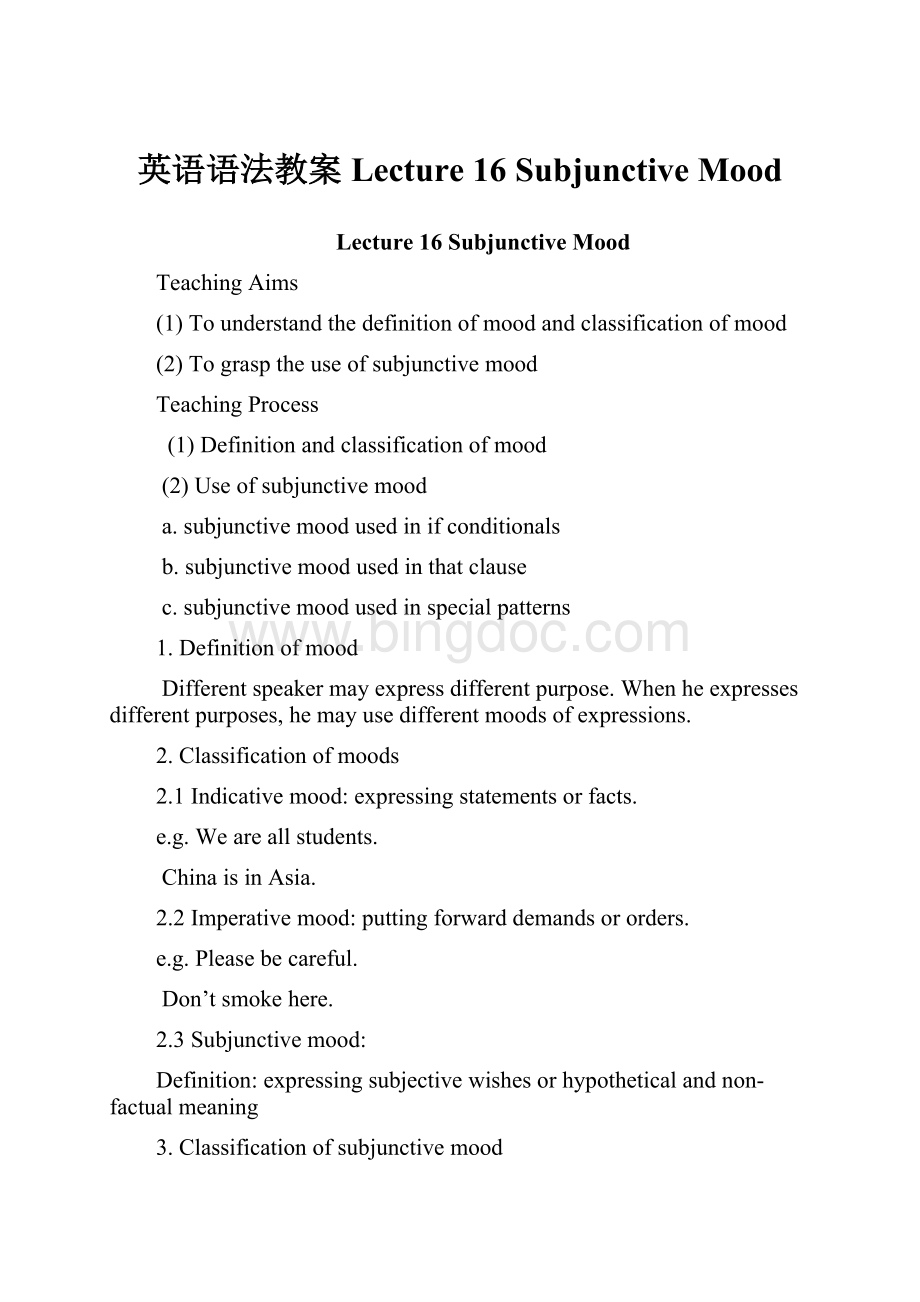英语语法教案 Lecture 16 Subjunctive Mood.docx
《英语语法教案 Lecture 16 Subjunctive Mood.docx》由会员分享,可在线阅读,更多相关《英语语法教案 Lecture 16 Subjunctive Mood.docx(21页珍藏版)》请在冰点文库上搜索。

英语语法教案Lecture16SubjunctiveMood
Lecture16SubjunctiveMood
TeachingAims
(1)Tounderstandthedefinitionofmoodandclassificationofmood
(2)Tograsptheuseofsubjunctivemood
TeachingProcess
(1)Definitionandclassificationofmood
(2)Useofsubjunctivemood
a.subjunctivemoodusedinifconditionals
b.subjunctivemoodusedinthatclause
c.subjunctivemoodusedinspecialpatterns
1.Definitionofmood
Differentspeakermayexpressdifferentpurpose.Whenheexpressesdifferentpurposes,hemayusedifferentmoodsofexpressions.
2.Classificationofmoods
2.1Indicativemood:
expressingstatementsorfacts.
e.g.Weareallstudents.
ChinaisinAsia.
2.2Imperativemood:
puttingforwarddemandsororders.
e.g.Pleasebecareful.
Don’tsmokehere.
2.3Subjunctivemood:
Definition:
expressingsubjectivewishesorhypotheticalandnon-factualmeaning
3.Classificationofsubjunctivemood
3.1Be-subjunctivemood
1)beisusedin“thatclause”containingthemeaningoforder,decision,suggestion.
a)usedin“thatclause”aftertheverbs:
decide,decree,demand,insist,move,order,prefer,propose,recommend,request,require,suggest,vote…
b)usedin“thatclause”aftertheadjectives:
advisable,appropriate,desirable,essential,fitting,imperative,important,impossible,necessary,obligatory,proper…
c)usedin“thatclause”afterthenouns:
decision,decree,demand,instruction,order,requirement,resolution…
2)beisusedin“thatclause”introducedby“if,though”
be-subjunctivemoodcanbeusedinthatclauseintroducedby“if,though,whatever,lest,solongas…”,suchsentenceshavethemeaningof“speculation,concession,orprecaution…”
3)beisusedinsomeformulasentencepatternstoexpress“wish,curse,orprohibition”
e.g.LonglivethePeople’sRepublicofChina!
Godblessyou!
Goddamnyou!
!
Heavenforbid!
Deviltakehim!
1
Sobeit!
Sufficeittosaythat…
Farbeitfrommetospoilthefun.
Hewillremainhereifneedbe.
Homeishome,beiteversohomely.
3.2were-Subjunctivemood
1)usedinsomeadverbialclause
usedinconditionalorconcessiveadverbialclauseintroducedby“if,ifonly,asthough,though…”
2)usedinsomenounclause
usedintheclauseintroducedby“wish,wouldrather,suppose,imagine…
4.Theuseofsubjunctivemood
4.1subjunctivemoodusedinif-conditional
Aconditionalsentence(or“conditional”forshort)iscommonlycomposedpart:
conditionalclause+mainclause.Despitethemanypossiblesequencesofverbformsinconditionals,thefollowingfourtypesrepresentperhapsthecommonestandthemostusefulones:
Ifyouheatice,itmelts.
Ifwecatchthe10o’clocktrain,wewillgettherebylunch-time.
Ifwecaughtthe10o’clocktrain,wewouldgettherebylunchtime.
Ifwehadcaughtthe10o’clocktrain,wewouldhavegottherebylunch-time.
1)Realconditional
A.Thefirstonecalled“whenever-type”inthat“if”hereisusedinthesenseof“whenever”.Itcanbeusedtodenotethefollowingmeanings:
a.Universaltruthorgeneralvalidity
Statementsofthistypecommonlyappearinfactualdiscussionsandscientificortechnicalmaterial.Thesequenceofverbformsisasfollows:
Ifsimplepresent+mainsimplepresent
E.g.Ifyoupouroilonwater,itfloats.
b.presenthabitualaction
Todenotepresenthabitualaction,ittakesthesamepattern.
Ifsimplepresent+mainsimplepresent
E.g.Ifitrains,Igotoworkbycar.
c.pasthabitualaction
Todenotepasthabitualaction,thesimplepastisusedinboththeconditionalandthemainclause.
Ifsimplepast+mainsimplepast.
E.g.IfImadeapromise,Ikeptit.
B.Thesecondfallsintothreeforms:
basicform,variantform,andalternativeform.
Basicforms:
a)(if)simplepresent+(mian)will,etc+infinitive
Ifitisfinetomorrow,wecanhaveapicnicsomewhere.
(if)simplepresent+(main)imperative
Ifyouwakeupbeforeme,givemeacall.
Variantforms:
a)(if)should+infinitive+(main)will,would,etc+infinitive
Ifheshouldcometomorrow,Iwouldtellhimeverything.
b)(if)will+infinitive+(main)will,would,etc+infinitive
Ifyouwouldreadmorecarefully,youwouldunderstandwhattheauthormeans.
Alternativeforms
a)imperative+and-clause
Setyouralarmclock,andyouwon’toversleep.
b)imperative+or-clause.
Setyouralarmclock,or(else)you‘lloversleep.
Whatwehaveenumerateaboveonlyrepresentthecommonesttypesofrealconditionals,whichareactuallytoovariegatedtobeexhaustedinafewpatterns.Asamatteroffact,therearefarmorepossiblesequencesofverbformsforrealconditionals.Solongastheydonotmakeunrealconditionals,almostallsequencesofverbformsarepossible.Thus,inadditiontotheabove-mentionedtypes,wecanalsosay,forexample:
Ifhehasfinishedhiswork,weshallbeabletotakehimwithus.
Ifyou’vebeentravelingallnight,youprobablyneedarest.
Lecture17&18Auxiliaryverb
Auxiliaryverbcanbedividedinto3types:
basicauxiliaryverb,
moodauxiliaryverb,
semi-auxiliaryverb.
17.1themeanstoexpressmoodmeanings
1)toexpress“Ability”and“possibility”:
can,could,beableto
2)toexpress“Permission”:
can/could,may/might
3)toexpress“Obligation”or“Necessity”:
should,oughtto,must
4)toexpress“Prediction”or“Predictability”
5)toexpress“Willingness”,“intention”or“Determination”:
will/would,shall
6)othermoodmeanings:
toexpress“pity,worry,happiness,surprise…”
17.2Epistemicusageornon-epistemicusageofmoodauxiliaryverb
1)themoodauxiliaryverbsservingasepistemicusage
a)
auxiliarymoodverbnon-epistemicusageepistemicusage
can/couldtoexpress“Ability”“Permission”toexpress“Possibility”
may/mighttoexpress“Permission”toexpress“Possibility”
will/wouldtoexpress“Willingness”toexpress“Predictability”
should/oughttotoexpress“Obligation”toexpress“Necessity”
musttoexpress“Obligation”toexpress“Necessity”
b)degreeofpossibility
UncertainmightThatmightbeGeorge.
↓may↓
could
can
should
oughtto
would
will
CertainmustThatmustbeGeorge.
2)syntaxcharactersofmoodauxiliaryverbwithepistemicmeaning
a)tense
b)there–be
c)staticverb
d)nounphraseoflifelessthings
3)moodauxiliaryverbwithepistemicmeaningandthereferredtime
18.1semi-auxiliaryverbs
1)thetypesofsemi-auxiliaryverb:
focusedon“be”;focusedon“have”;focusedon“seem”
canbetransformedinto“it…that”cannottransformed
beabouttobecertainto
beabletobe(un)likelyto
beapttoappearto
beboundtochanceto
beduetohappento
begoingtoseemto
beliabletoturnoutto…
beobligedto
besupposedto
besureto
beto
bewillingto
hadbetter/best
haveto
havegotto
cometo
failto
getto
tendto…
2)semi-auxiliaryand“it…that”structure
Lecture19&20Infinitive
TeachingAims
(1)Tounderstandnon-finiteverbs
(2)Tograsptheformofinfinitiveverbs
(3)Tograsptheuseofinfinitiveverb
TeachingContent
(1)Classificationofverb
(2)Characteristicsofnon-finiteverbandclassificationofnon-finiteverb
(3)Infinitiveverb
a.theformsofinfinitiveverb
b.changeofformintenseandaspectandvoice
c.thelogicalsubject
d.usageofinfinitiveverb
e.transformationfrominfinitiveintoclause
(4)Notices
1.Grammaticalforms
Theinfinitivehasnotensedistinctions,norpersonornumbercontrast.Buttheycanbepassiveandtakethesimple,progressive,perfectandperfectprogressiveforms.
Anegativeinfinitiveisformedbyaddingnotorneverimmediatelybeforetheinfinitivesignto.
2.Formsoftheinfinitive
Therearetwotypesofinfinitive:
to-infinitiveandbareinfinitive.Thebareinfinitivejusttheinfinitivewithoutto,whichisidenticalinformwiththebaseoftheverb.
2.1Infinitivecommonlyoccurswithto,butinsomecontextsitisnecessarytousethebareinfinitive,andinsomeothercasestheinfinitivesignisoptional.
Followingissummingupofthesituationsinwhichthebareinfinitiveisused.
1)thebareinfinitiveisgenerallyusedtofollowthemodalsincludingneedanddare.
2)thebareinfinitiveisusedtofollowsemi-auxiliaries.
3)thebareinfinitiveisusedtocombinewithsuchmodalidiomsaswouldrather,wouldsooner,would(just)assoon,may/might/(just)aswell,cannotbut,cannothelpbut,etc.
4)thebareinfinitiveiscommonlyusedtofollowratherthanandsoonerthan,especiallywhenrather/soonerthantakestheinitialposition.
e.g.Ratherthancausetrouble,heleft.
Soonerthanmarrythatman,shewouldearnherlivingasawaitress.
Butwhenratherthantakesotherpositionsinthesentence,thefollowinginfinitivemaybewithorwithoutto.
e.g.Hedecidedtogofishingratherthanstayintheschool.
Themanagerbelievesitisimportanttoinvestinnewmachineryratherthantoincreasewages.
5)thebareinfinitiveisoftencombinedwithamainverbtoformsomefixedcombinationssuchas:
makebelieveletslipletdownleavegoletfallheartell
6)thebareinfinitiveusuallyappearsafter“causativeverb+object”,butwhenthecausativeverboccursinthepassive,thebareinfinitivshouldbeturnedintoato-infinitive.
e.g.TommadeMarrydothecleaning.
Marrywasmadetodothecleaning.
7)thebareinfinitiveusuallyoccursafter“senseverb+object”.Thesenseverbsincludesee,hear,observe,notice,feel,watch,lookat,listento.Butwhenthesenseverboccursinthepassive,itshouldbefollowedbyato-infinitive.
8)thebareinfinitiveisusedafter“haveknown+object”,e.g.
Ihaveneverknownthatmansmile.
9)thebareinfinitiveoftenappears